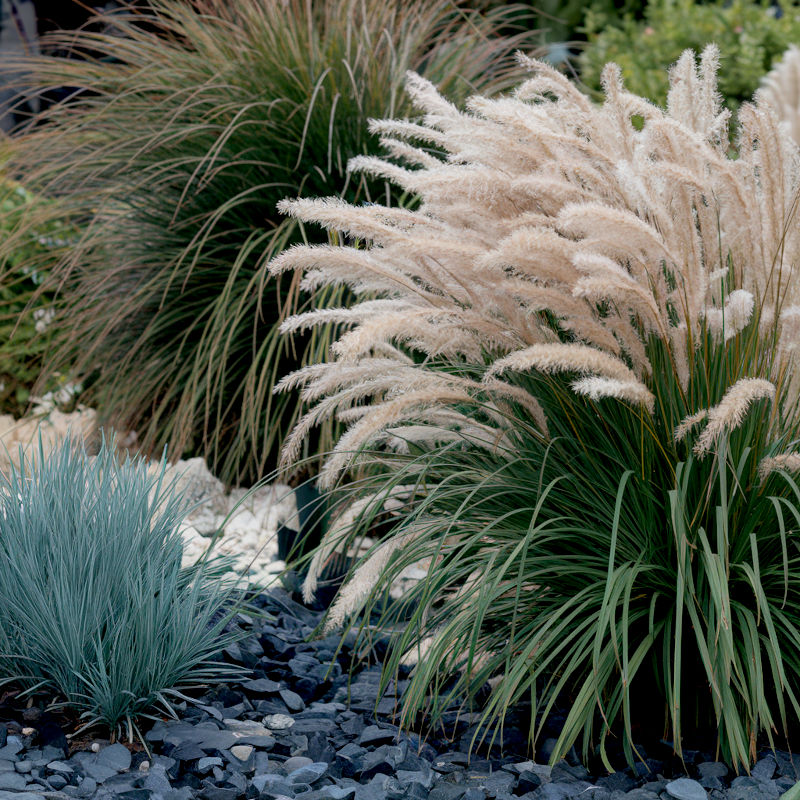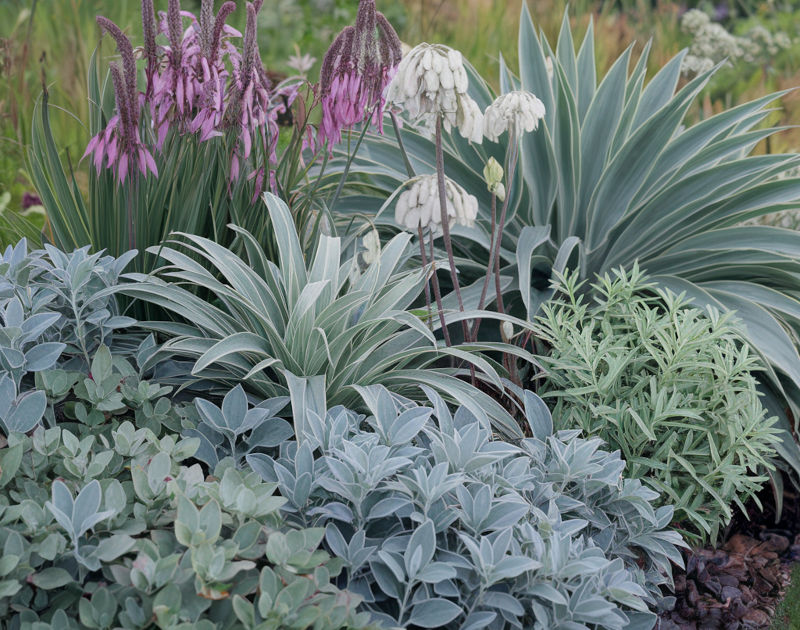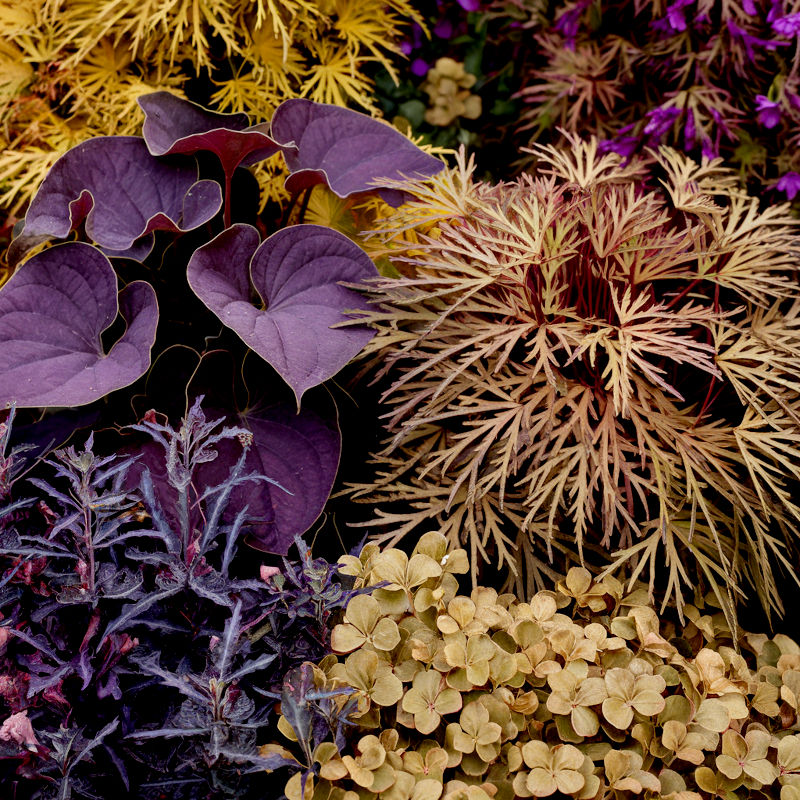Pete Jorgensen
Plant Science & Horticulture
Managing Outdoor Garden Beds for Biological Threats
Ornamental Grasses
Ornamental garden beds can contain a variety of grasses of differing heights, colours, and textures. For example, there are several varieties of the Asian Miscanthus sinensis Andersson including ‘Gold Bar’, ‘Malepartus’ and ‘Zebrinus’. These are tall grasses ranging from around 4ft to 6ft in height. They often work well with shorter clump forming grasses such as Carex oshimensis Nakai, Imperata cylindrica (L.) Raeusch. ‘Rubra’ and Festuca glauca Vill.

Using slate or stone mulches in ornamental grass garden beds can be visually effective, and reduce maintenance.
Keeping plants healthy is an important step in ensuring their natural defences against biological threats are strong. Many grass species tolerate a range of soil pH, but Briza media L. prefers an alkaline limestone soil; by contrast Molinia caerulea (L.) Moench dislikes overly alkaline conditions. If planted together, sensible practice would be to maintain a near neutral level, and see how the Briza performs. If deemed necessary, add a little additional lime around it while ensuring the Molinia is not likely to experience a change of pH from leaching of the lime.
Carex siderosticta Hance requires shade or at least part shade. This type of grass also requires a damp soil, but will grow in moist soil whereas others such as the Miscanthus can tolerate dry conditions, but will not respond well to being in very damp conditions. A sensible arrangement would be to plant the Carex towards to the north end of a bed, and maintain a watering regimen to ensure that the bed remains moist during the summer months.
For maintenance, keep beds free of weeds; this is especially important as some of the grasses such as the Briza and Festuca do not deal well with competition or crowding. Deciduous grasses should be cut back hard in spring – evergreens will generally only require tidying up by removing dead and damaged leaves. Most grasses can be divided in late spring if required. Dividing should be done to keep grasses from spreading too far, and also to revive any tired looking plants.
Grasses do not generally suffer severe damage from pests and diseases, although it is a good idea to monitor new growth to ensure aphids do not become a severe problem. Avoiding overhead watering, ensure soil does not become too damp, and providing for adequate ventilation. This will usually be enough to prevent rust, which can also be problematic when conditions allow it to thrive.
Fertility generally needs to be kept low to avoid floppy growth. However, the Royal Horticultural Society suggest that Briza media requires a fertile soil. A light application of general low nitrogen fertilizer in spring should be sufficient.
Plants with Silver(ish) Foliage
Plants with silvery foliage, stems, and white flowers, can be a stunning addition to any display garden. Evergreen and deciduous perennials, interplanted with a small number of shrubs can provide year round interest. Often, the most striking display will be over the summer months. Many 'silver' plants are suited to full sun, or slight shade. A notable exception is the Pulmonaria ‘Diana Clare’, which needs full shade or part shade. This is a groundcover plant, placing taller plants nearby will often suffice.

Silvery foliage plants can often produce good visual effect year round, with striking summer florescence.
For maintenance, regular weeding is essential. It is good practice to divide perennials such as Anaphalis triplinervis (Sims) Sims ex C.B.Clarke, Stachys byzantina K. Koch, Geranium macrorrhizum L. ‘White Ness’, Agapanthus L. ‘Ben hope’, in the spring. This will rejuvenate tired plants and control spread. For many species, dividing can also be done in the autumn (Hessayon, 1999). Pruning of shrubs will also be required. Gomphostigma virgatum (L.f.) Baill. may require cutting back in late winter if it has not died back; this will help to keep it vibrant. Lonicera ligustrina var. yunnanensis Franch. ‘Silver Beauty’, often incorrectly called Lonicera nitida E.H. Wilson, can be pruned from spring through autumn. However, Euonymous fortunei ‘Emerald Gaiety’ (Turcz.) Hand- Mazz. is best pruned mid to late spring, no later.
Mulching is specifically recommended for Agapanthus ‘Ben Hope’ to protect it from harsher winters. It also good general practice for perennial beds. Applying a mulch in autumn will help protect the plants over the winter, and a late spring mulch can help to suppress weeds, retain moisture over summer, and make beds look more attractive to visitors. Applying a mulch of fine pine bark, or similar, to a depth of 1-2 inches in spring, after any division and pruning has been carried out, is recommended. Ensure that the crowns of perennials are kept clear to avoid causing any rot. A follow up autumn inspection can be carried out and the mulch topped up if required. Watering should be carried out as required, ensuring that beds remain moist throughout spring, summer, and autumn. As with the grasses it is good practice to avoid overhead watering, and don't use too high a water pressure because surface pathogens are often spread by the spray.
Planting a 'Royal' Bed of Purple and Gold
Purple and Gold are rich, vibrant colours, associated with Royalty, and high spirituality. A mixture of deciduous and evergreen perennials, and shrubs, can be used to great effect.
Maintenance is much the same as it is for the silvery garden beds. Plants such as Cirsium rivulare ‘Atropurpureum’ (Jacq.) All., and Houttuynia cordata Thunb., will need dividing in spring. If using Bergenia cordifolia (Haw.) Sternb. ‘Purpurea’, this should be divided in autumn. Cut back Polygonum microcephalum D. Don (usually incorrectly called Persicaria microcephala) ‘Red Dragon’ in autumn.

Mix gold and purple plants for a garden bed with spiritually-elevated symbolism.
Bibliography
Beth Chatto Gardens, 2016. Geranium macrorrhizum 'White Ness'. [Online]
Available at: http://www.bethchatto.co.uk/e-h/geranium-border-types/geranium-macrorrhizum-
white-ness.htm
[Accessed 12 December 2016].
Ciancio, A. & Mukerji, K., 2008. Integrated Management of Diseases Caused by Fungi, Phytoplasma
and Bacteria. 1st ed. Heidelberg: Springer.
DiSabato-Aust, T., 2006. The Well-Tended Perennial Garden: Planting & Pruning Techniques. 1st ed.
Oregon: Timber Press.
Edulis, 2016. Carex Siderosticha ‘Variegata’. [Online]
Available at: http://www.edulis.co.uk/products/carex-siderosticha-variegata
[Accessed 15 December 2016].
Hessayon, D. G., 1999. The New Flower Expert. 1st ed. London: Transworld Publishers Ltd.
Holmes, R., 1997. Taylor's Guide to Ornamental Grasses. 1st ed. Hong Kong: Houghton Mifflin.
Kingsbury, N., 2007. Grasses and Bamboos. 2nd ed. London: Ryland,Peters and Small.
Murphy, E., 2015. Building Soil: A down-to-earth approach. 1st ed. Minneapolis: Cool Springs Press.
Royal Horticultural Society, 2016. Alchemilla mollis. [Online]
Available at: https://www.rhs.org.uk/Plants/774/Alchemilla-mollis/Details
[Accessed 20 December 2016].
Royal Horticultural Society, 2016. Carex oshimensis 'Evergold'. [Online]
Available at: https://www.rhs.org.uk/Plants/45191/Carex-oshimensis-Evergold-(v)/Details
[Accessed 10 December 2016].
Royal Horticultural Society, 2016. Euonymus fortunei 'Emerald Gaiety'. [Online]
Available at: https://www.rhs.org.uk/Plants/97545/Euonymus-fortunei-Emerald-Gaiety-(v)/Details
[Accessed 18 December 2016].
Royal Horticultural Society, 2016. Hosta 'Golden Tiara'. [Online]
Available at: https://www.rhs.org.uk/Plants/96811/Hosta-Golden-Tiara-(v)/Details
[Accessed 18 December 2016].
Royal Horticultural Society, 2016. Houttuynia cordata 'Chameleon'. [Online]
Available at: https://www.rhs.org.uk/Plants/90526/i-Houttuynia-cordata-i-Chameleon-(v)/Details
[Accessed 18 December 2016].
Royal Horticultural Society, 2016. Humulus lupulus 'Aureus'. [Online]
Available at: https://www.rhs.org.uk/Plants/91715/Humulus-lupulus-Aureus/Details
[Accessed 18 December 2016].
Royal Horticultural Society, 2016. Ilex × altaclerensis. [Online]
Available at: https://www.rhs.org.uk/Plants/97711/i-Ilex-i-times;-i-altaclerensis-i/Details
[Accessed 18 December 2016].
Royal Horticultural Society, 2016. Imperata cylindrica 'Rubra'. [Online]
Available at: https://www.rhs.org.uk/Plants/94352/Imperata-cylindrica-Rubra/Details
[Accessed 9 December 2016].
Royal Horticultural Society, 2016. Lonicera nitida. [Online]
Available at: https://www.rhs.org.uk/Plants/10499/i-Lonicera-nitida-i/Details
[Accessed 21 December 2016].
Royal Horticultural Society, 2016. Pulmonaria 'Diana Clare'. [Online]
Available at: https://www.rhs.org.uk/Plants/135762/Pulmonaria-Diana-Clare/Details
[Accessed 27 December 2016].
Scott-Macnab, J., 1997. Reader's Digest New Encyclopedia of Garden Plants and Flowers. 1st ed.
London: Reader's Digest Association.
Shoot, 2016. Agapanthus 'Ben Hope' (African lily 'Ben Hope'). [Online]
Available at: https://www.shootgardening.co.uk/plant/agapanthus-ben-hope
[Accessed 26 December 2016].
The Plant List, 2012. Lonicera ligustrina var. yunnanensis Franch.. [Online]
Available at: http://www.theplantlist.org/tpl1.1/record/tro-50041104
[Accessed 20 December 2016].
The Plant List, 2012. Polygonum microcephalum D. Don. [Online]
Available at: http://www.theplantlist.org/tpl1.1/record/tro-50133822
[Accessed 28 December 2016].
University of Illinois, 2016. Care & Maintenance of Ornamental Grasses. [Online]
Available at: https://extension.illinois.edu/grasses/care.cfm
[Accessed 20 December 2016].